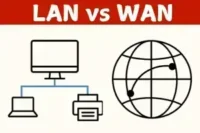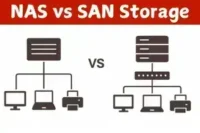Daisy Chain Topology Advantages and Disadvantages
Published: February 10, 2025
Did you know that daisy chain topology is one of the simplest ways to connect multiple devices in a network? It’s commonly used in small office setups, IoT devices, and gaming controllers. However, while it’s easy to set up, it comes with risks like complete failure if one device breaks. Let’s explore the advantages and disadvantages of daisy chain topology to see if it’s the right choice for you.

What is Daisy Chain Topology?
Daisy chain topology is a method in which each device connects to the next in a linear sequence. It is like a string of holiday lights—if one light fails, the others might be affected. This setup is standard in networking, audio, and industrial control systems.
Daisy Chain Topology Advantages and Disadvantages
Now, let’s examine why this topology can be helpful and where it may cause problems.
Advantages of Daisy Chain Topology
Exploring the advantages of Daisy Chain Topology will highlight why it’s a preferred option for many.
- Easy to Set Up
- Cost-Effective
- Minimal Hardware Requirements
- Good for Small Networks
- Useful in Audio and Video Systems
- Scalability (Up to a Limit)
1. Easy to Set Up
One of the biggest reasons people use daisy chain topology is its simplicity. Since devices are connected one after another, there is no need for complex wiring or additional hardware. It makes it a good choice for small networks or essential device connections.
2. Cost-Effective
Because fewer cables and networking devices (such as hubs or switches) are required, daisy chains help reduce expenses. This makes them ideal for low-budget setups, especially in home automation and small office environments.
3. Minimal Hardware Requirements
Unlike star or mesh topologies, daisy chains don’t need a central hub or router to function. Each device connects directly to the next, reducing dependency on extra equipment.
4. Good for Small Networks
Daisy chaining works well for a small number of devices. It provides a straightforward way to share resources, such as printers and external drives, without a complete networking infrastructure.
5. Useful in Audio and Video Systems
Many professional audio and video setups connect speakers, monitors, and lighting systems using daisy chains. It allows for better synchronization and reduces cable clutter.
6. Scalability (Up to a Limit)
You can extend a daisy chain by adding more devices. This method can help expand a network or system without much effort as long as the chain does not become too long.
Disadvantages of Daisy Chain Topology
While Daisy Chain Topology has its benefits, it also comes with some drawbacks you should consider.
- Single Point of Failure
- Performance Issues with Large Networks
- Limited Scalability
- Difficult Troubleshooting
- Not Ideal for High Data Traffic
- Power Dependency
1. Single Point of Failure
The biggest drawback of a daisy chain is its dependency on each device. If one device malfunctions or loses power, all devices connected after it may stop working. It makes it unreliable for critical systems.
2. Performance Issues with Large Networks
As the number of devices increases, data transmission slows down. Each device in the chain must pass data to the next one, causing delays and bottlenecks. It can be a significant issue in large-scale networks.
3. Limited Scalability
While it is easy to add a few devices, too many can lead to instability. Longer chains increase latency and the risk of failure, making them unsuitable for high-performance environments.
4. Difficult Troubleshooting
Finding the faulty device can be time-consuming if something goes wrong in a daisy chain. Since all devices are interconnected, you may need to check each individually to locate the problem.
5. Not Ideal for High Data Traffic
A daisy chain topology is not efficient for networks handling large amounts of data. Since data must pass through multiple devices before reaching its destination, speed and reliability suffer.
6. Power Dependency
Some daisy chains rely on power passing through connected devices. If one device turns off, others may lose control. It is common in USB daisy chains and some industrial setups.
When to Use Daisy Chain Topology
Daisy chaining is suitable for:
- Small home or office networks
- Audio and video equipment setups
- Simple industrial automation systems
- Temporary or low-cost networking solutions
When to Avoid Daisy Chain Topology
Avoid using a daisy chain if:
- You need a high-speed and reliable network
- The system must remain operational even if one device fails
- You are handling large data transfers
- The network needs to be easily expandable
Conclusion
We’ve covered the advantages and disadvantages of daisy chain topology in detail. While this setup can be cost-effective and straightforward, it is important to assess whether it suits your network needs. I recommend using daisy chain topology only for small-scale setups where reliability isn’t a top priority. If you need a more stable connection, consider hybrid network designs.
Take the time to explore daisy chain topology advantages and disadvantages further and see how they align with your goals. The more you understand, the better decisions you’ll make for your network.
FAQs About Daisy Chain Topology Advantages and Disadvantages
Daisy chain topology is a way of connecting devices in a line, one after another. Data must pass through all the devices in between if data needs to travel to a far device. This setup is simple but can cause issues if one device fails.
No, they are different. In a bus topology, all devices are connected to a single main cable, but in a daisy chain, each device is linked to only two others (except the first and last ones). However, both can suffer from network failures if a key connection breaks.
If one device in the chain fails, the entire connection for the devices can be broken. It makes daisy chain topology risky for large networks where continuous connectivity is essential.
It’s not ideal for large networks because if one device stops working, everything will lose connection after it stops working. More extensive networks usually use star or mesh topologies for better stability and faster data transfer.
The most significant advantages are its simplicity and low cost. Since it requires fewer cables and is easy to set up, it’s excellent for small-scale networks like home automation or simple office setups.
The significant drawbacks are high failure risk and slow performance. If one device fails, the whole chain can break, and as more devices are added, the data transfer can become sluggish.
Yes! Many networks combine daisy chains with star or mesh topologies to improve reliability. For example, in a hybrid setup, a star topology can ensure backup connections if a device in the daisy chain fails.
No, it’s not ideal for high-speed needs. Because data passes through multiple devices can create delays and slowdowns, which are bad for gaming, video calls, or streaming.
There’s no fixed limit, but the more devices you add, the slower and less stable the network becomes. Most small networks keep it under 5-10 devices to avoid performance issues.
To improve reliability, you can add backup connections, use high-quality cables, or limit the number of devices in the chain. Consider a hybrid setup to prevent complete failures.





